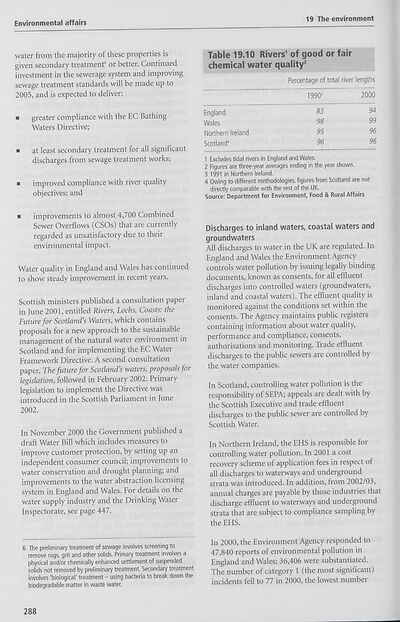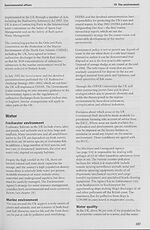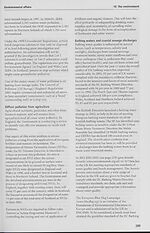Download files
Complete book:
Individual page:
Thumbnail gallery: Grid view | List view

Environmental affairs
19 The environment
water from the majority of these properties is
given secondary treatment6 or better. Continued
investment in the sewerage system and improving
sewage treatment standards will be made up to
2005, and is expected to deliver:
■ greater compliance with the EC Bathing
Waters Directive;
■ at least secondary treatment for all significant
discharges from sewage treatment works;
■ improved compliance with river quality
objectives; and
■ improvements to almost 4,700 Combined
Sewer Overflows (CSOs) that are currently
regarded as unsatisfactory due to their
environmental impact.
Water quality in England and Wales has continued
to show steady improvement in recent years.
Scottish ministers published a consultation paper
in June 2001, entitled Rivers, Lochs, Coasts: the
Future for Scotland’s Waters, which contains
proposals for a new approach to the sustainable
management of the natural water environment in
Scotland and for implementing the EC Water
Framework Directive. A second consultation
paper, The future for Scotland’s waters, proposals for
legislation, followed in February 2002. Primary
legislation to implement the Directive was
introduced in the Scottish Parliament in June
2002.
In November 2000 the Government published a
draff Water Bill which includes measures to
improve customer protection, by setting up an
independent consumer council; improvements to
water conservation and drought planning; and
improvements to the water abstraction licensing
system in England and Wales. For details on the
water supply industry and the Drinking Water
Inspectorate, see page 447.
6 The preliminary treatment of sewage involves screening to
remove rags, grit and other solids. Primary treatment involves a
physical and/or chemically enhanced settlement of suspended
solids not removed by preliminary treatment. Secondary treatment
involves 'biological' treatment - using bacteria to break down the
biodegradable matter in waste water.
Table 19.10 Rivers1 of good or fair
chemical water quality2
Percentage of total river lengths
19903 2000
England 83 94
Wales 98 99
Northern Ireland 95 96
Scotland4 96 96
1 Excludes tidal rivers in England and Wales.
2 Figures are three-year averages ending in the year shown.
3 1991 in Northern Ireland.
4 Owing to different methodologies, figures from Scotland are not
directly comparable with the rest of the UK.
Source: Department for Environment, Food & Rural Affairs
Discharges to inland waters, coastal waters and
groundwaters
All discharges to water in the UK are regulated. In
England and Wales the Environment Agency
controls water pollution by issuing legally binding
documents, known as consents, for all effluent
discharges into controlled waters (groundwaters,
inland and coastal waters). The effluent quality is
monitored against the conditions set within the
consents. The Agency maintains public registers
containing information about water quality,
performance and compliance, consents,
authorisations and monitoring. Trade effluent
discharges to the public sewers are controlled by
the water companies.
In Scotland, controlling water pollution is the
responsibility of SEPA; appeals are dealt with by
the Scottish Executive and trade effluent
discharges to the public sewer are controlled by
Scottish Water.
In Northern Ireland, the EHS is responsible for
controlling water pollution. In 2001 a cost
recovery scheme of application fees in respect of
all discharges to waterways and underground
strata was introduced. In addition, from 2002/03,
annual charges are payable by those industries that
discharge effluent to waterways and underground
strata that are subject to compliance sampling by
the EHS.
In 2000, the Environment Agency responded to
47,840 reports of environmental pollution in
England and Wales; 36,406 were substantiated.
The number of category 1 (the most significant)
incidents fell to 77 in 2000, the lowest number
288
19 The environment
water from the majority of these properties is
given secondary treatment6 or better. Continued
investment in the sewerage system and improving
sewage treatment standards will be made up to
2005, and is expected to deliver:
■ greater compliance with the EC Bathing
Waters Directive;
■ at least secondary treatment for all significant
discharges from sewage treatment works;
■ improved compliance with river quality
objectives; and
■ improvements to almost 4,700 Combined
Sewer Overflows (CSOs) that are currently
regarded as unsatisfactory due to their
environmental impact.
Water quality in England and Wales has continued
to show steady improvement in recent years.
Scottish ministers published a consultation paper
in June 2001, entitled Rivers, Lochs, Coasts: the
Future for Scotland’s Waters, which contains
proposals for a new approach to the sustainable
management of the natural water environment in
Scotland and for implementing the EC Water
Framework Directive. A second consultation
paper, The future for Scotland’s waters, proposals for
legislation, followed in February 2002. Primary
legislation to implement the Directive was
introduced in the Scottish Parliament in June
2002.
In November 2000 the Government published a
draff Water Bill which includes measures to
improve customer protection, by setting up an
independent consumer council; improvements to
water conservation and drought planning; and
improvements to the water abstraction licensing
system in England and Wales. For details on the
water supply industry and the Drinking Water
Inspectorate, see page 447.
6 The preliminary treatment of sewage involves screening to
remove rags, grit and other solids. Primary treatment involves a
physical and/or chemically enhanced settlement of suspended
solids not removed by preliminary treatment. Secondary treatment
involves 'biological' treatment - using bacteria to break down the
biodegradable matter in waste water.
Table 19.10 Rivers1 of good or fair
chemical water quality2
Percentage of total river lengths
19903 2000
England 83 94
Wales 98 99
Northern Ireland 95 96
Scotland4 96 96
1 Excludes tidal rivers in England and Wales.
2 Figures are three-year averages ending in the year shown.
3 1991 in Northern Ireland.
4 Owing to different methodologies, figures from Scotland are not
directly comparable with the rest of the UK.
Source: Department for Environment, Food & Rural Affairs
Discharges to inland waters, coastal waters and
groundwaters
All discharges to water in the UK are regulated. In
England and Wales the Environment Agency
controls water pollution by issuing legally binding
documents, known as consents, for all effluent
discharges into controlled waters (groundwaters,
inland and coastal waters). The effluent quality is
monitored against the conditions set within the
consents. The Agency maintains public registers
containing information about water quality,
performance and compliance, consents,
authorisations and monitoring. Trade effluent
discharges to the public sewers are controlled by
the water companies.
In Scotland, controlling water pollution is the
responsibility of SEPA; appeals are dealt with by
the Scottish Executive and trade effluent
discharges to the public sewer are controlled by
Scottish Water.
In Northern Ireland, the EHS is responsible for
controlling water pollution. In 2001 a cost
recovery scheme of application fees in respect of
all discharges to waterways and underground
strata was introduced. In addition, from 2002/03,
annual charges are payable by those industries that
discharge effluent to waterways and underground
strata that are subject to compliance sampling by
the EHS.
In 2000, the Environment Agency responded to
47,840 reports of environmental pollution in
England and Wales; 36,406 were substantiated.
The number of category 1 (the most significant)
incidents fell to 77 in 2000, the lowest number
288
Set display mode to:
![]() Universal Viewer |
Universal Viewer | ![]() Mirador |
Large image | Transcription
Mirador |
Large image | Transcription
The item on this page appears courtesy of Office for National Statistics and may be re-used under the Open Government Licence for Public Sector Information.
| Britain and UK handbooks > UK: The official yearbook of the United Kingdom of Great Britain and Northern Ireland > 2003 > (322) |
|---|
| Permanent URL | https://digital.nls.uk/204927296 |
|---|
| Attribution and copyright: |
|
|---|---|
| Description | Three volumes of 'UK: The official yearbook of the United Kingdom of Great Britain and Northern Ireland', published annually by the Office of National Statistics from 2002-2005. |
|---|---|
| Shelfmark | GII.11 SER |
| Description | Three titles produced by the British Government from 1954-2005 describing 'how Britain worked'. They are: 'Britain: An official handbook' (1954-1998), 'Britain: The official yearbook of the United Kingdom' (1999-2001), and 'UK: The official yearbook of the United Kingdom of Great Britain and Northern Ireland' (2002-2005). These 50 reports provide an overview of Britain's economic, social and cultural affairs, its environment, international relations, and the systems of government. They give an impartial summary of government policies and initiatives, and explain how public services are organised. |
|---|---|
| Additional NLS resources: |
|

